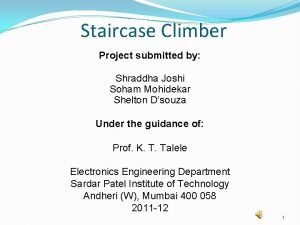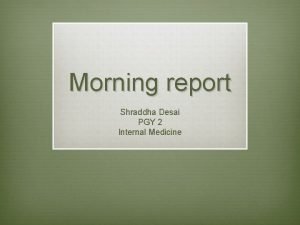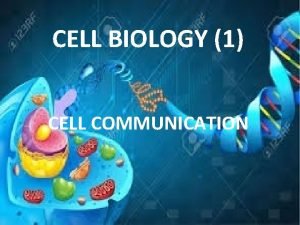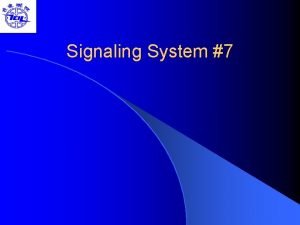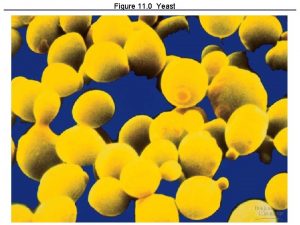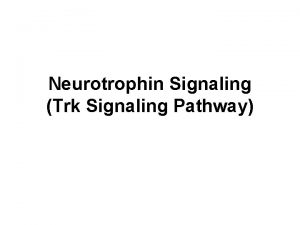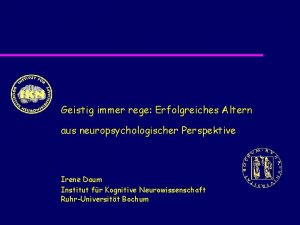GHRELIN SIGNALING PATHWAY SHRADDHA D REGE Ghrelin u















- Slides: 15

GHRELIN SIGNALING PATHWAY - SHRADDHA D. REGE

Ghrelin u. Is a 28 amino acid Orexigenic peptide and hormone. u. Neuroendocrine hormone – exerts numerous physiological roles. u Ghrelin levels increase before meals and decrease after meals.

Ghrelin Production Produced mainly by P/D 1 cells of oxyntic gland abundantly present in the mucosal layer of the fundus region of the stomach. Gastric fundus contains 1020 times more Ghrelin than duodenum, the next richest source.

Overview of Ghrelin secretion and feedback mechanism

Mechanism of Action Receptors for ghrelin have been found on NPY neurons in the hypothalamic arcuate nucleus, a major brain area involved in the control of appetite. The NPY neurons are potent stimulators of appetite and upon activation by ghrelin they inhibit the POMC neurons by releasing the inhibitory neurotransmitter GABA which inhibits the release of alpha MSH, an inhibitor of appetite. Ghrelin also activates the release of Ag. RP which is an antagonist of the alpha MSH receptors MC 3 and MC 4, blocking alpha MSH from activating its receptor which inhibits appetite.

Mechanism of Action

Neuroendocrine regulation of central feeding and Growth hormone release

The Ghrelin Receptor: Growth hormone secretagogue Receptor (GHS-R 1 a) Ghrelin is an endogenous ligand for GHS-R 1 a. Ghrelin is a potent stimulator of growth hormone secretion from Anterior pituitary gland. GHS-R 1 a is a 7 trans-membrane G protein coupled receptor. Two isoforms of the GHS-R : GHS-R 1 a and GHS-R 1 b, but only the GHS-R 1 a isoform appears to functionally transduce ghrelin signaling. Ghrelin receptors are expressed in a wide variety of tissues, including the pituitary, stomach, intestine, pancreas, thymus, gonads, thyroid, and heart.

Ghrelin Signaling (Castaneda et al. 2010)

Binding of ghrelin to its receptor (GHSR) leads to an exchange of GDP for GTP in Gαq. The GTP-bound α-subunit separates from Gβγ and recruits PLCβ to the membrane, next to its substrate phosphatidylinositol-4, 5 -bisphosphate (PI-4, 5 -P 2 or PIP 2). An enzymatic reaction ensues that lead to the formation of a soluble second messenger, inositol-1, 4, 5 -trisphosphate (IP 3) and a membrane bound second messenger, diacylglycerol (DAG).

Ca 2+-mediated inactivation of m. TOR gives rise to an orectic (food-seeking) signal IP 3 binds to its receptor and causes release of Ca 2+ from ER. Intracellular free Ca 2+ binds calmodulin (Ca. M), this binds to Ca. Mkinase (Ca. MKK) which acts as the activator of AMPK. This leads to phosphorylation and activation of Gtpase complex TSC 1/TSC 2. . Because of this, the small G-protein Rheb is kept in a resting (GDP-bound) state and this causes inactivation of the m. TOR protein kinase. From here on matters are not yet investigated but inactivation of m. TOR leads to an orexictic signal.

Ghrelin-mediated activation of AMPK leads to phosphorylation and inactivation of acetyl-Co. A carboxylase. The ensuing lack of fatty acid synthesis and subsequent increase in β-oxidation plays a role in the generation of an orectic signal.

Ghrelin augments the firing rate of NPY, Ag. RP, GABA neurons and augments the production of Ag. RP/NPY (neurotransmitters). Subsequent GABA release reduces the firing rate of POMC neurons (hyperpolarization). Result : dominant activity of orexigenic neurons

Ghrelin in Diseased State • In obese individuals : Ghrelin concentrations in blood are reduced compared to lean control subjects, but whether this is cause or effect is not defined. • In patients with anorexia nervosa : Ghrelin concentartions in blood are higher than normal plasma ghrelin levels, which decrease if weight gain occurs. • Prader-Willi syndrome is another disorder relevant to ghrelin science. Affected patients develop extreme obesity associated with uncontrollable and voracious appetite. The plasma ghrelin levels are exceptionally high in comparison to patients similarly obese due to other causes. Prader-Willi syndrome is clearly a complex disease with many defects; it may be that excessive ghrelin production contributes to the appetite and obesity components.

Thank you
 Rege a csodaszarvasról
Rege a csodaszarvasról Shraddha upadhyaya
Shraddha upadhyaya Shraddha opticals
Shraddha opticals Dr shraddha desai
Dr shraddha desai Ligand signaling molecule
Ligand signaling molecule Cell signaling
Cell signaling Vocabulary in discourse
Vocabulary in discourse Exocrine cell signaling
Exocrine cell signaling Respond to
Respond to Use visual signaling techniques
Use visual signaling techniques Strategies in embryonic and growth industries
Strategies in embryonic and growth industries Signaling system 7
Signaling system 7 Cell signaling overview
Cell signaling overview Discourse organizers
Discourse organizers Paracrine signaling
Paracrine signaling Dot
Dot


